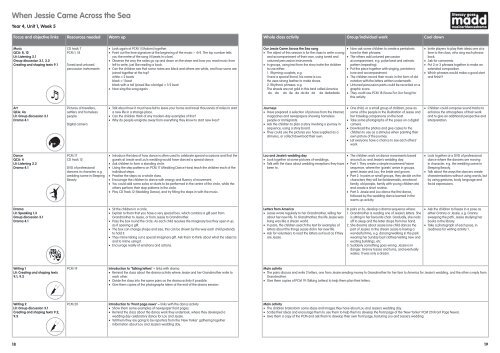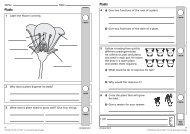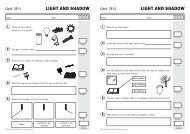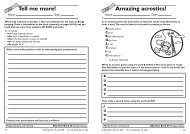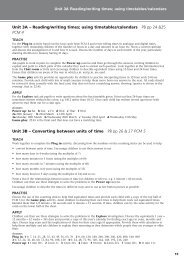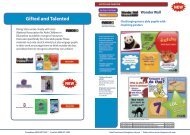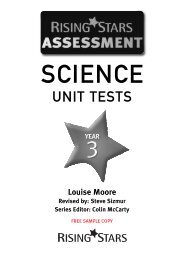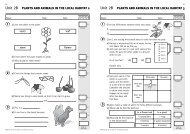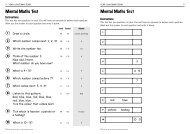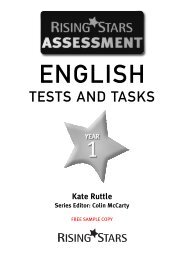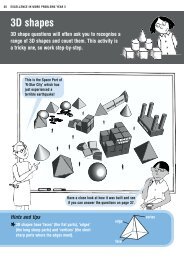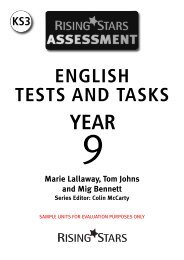When Jessie Came Across the Sea - Rising Stars
When Jessie Came Across the Sea - Rising Stars
When Jessie Came Across the Sea - Rising Stars
Create successful ePaper yourself
Turn your PDF publications into a flip-book with our unique Google optimized e-Paper software.
<strong>When</strong> <strong>Jessie</strong> <strong>Came</strong> <strong>Across</strong> <strong>the</strong> <strong>Sea</strong>Year 4, Unit 1, Week 5Focus and objective links Resources needed Warm up<strong>When</strong> <strong>Jessie</strong> <strong>Came</strong> <strong>Across</strong> <strong>the</strong> <strong>Sea</strong>Year 4, Unit 1, Week 5Whole class activity Group/individual work Cool downMusicQCA: 8, 12Lit: Listening 2.1Group discussion 3.1, 3.2Creating and shaping texts 9.1CD track 7PCM 1, 18Tuned and untunedpercussion instruments• Look again at PCM 1 (Shalom) toge<strong>the</strong>r.• Point out <strong>the</strong> time signature at <strong>the</strong> beginning of <strong>the</strong> music ~ 4/4. The top number tellsyou <strong>the</strong> metre of <strong>the</strong> song (4 beats in a bar).• Observe <strong>the</strong> way <strong>the</strong> notes go up and down on <strong>the</strong> stave and how you read music fromleft to write, just like reading a book.• Can <strong>the</strong> children see that some notes are black and o<strong>the</strong>rs are white, and how some arejoined toge<strong>the</strong>r at <strong>the</strong> top?white = 2 beatsblack = 1 beatblack with a tail (joined like a bridge) = 1/2 beat• Now sing <strong>the</strong> song again.Our <strong>Jessie</strong> <strong>Came</strong> <strong>Across</strong> <strong>the</strong> <strong>Sea</strong> song• The object of this session is for <strong>the</strong> class to write a songand accompaniment of <strong>the</strong>ir own, using tuned anduntuned percussion instruments.• In groups, using text from <strong>the</strong> story invite <strong>the</strong> childrento use ei<strong>the</strong>r:1. Rhyming couplets, e.g.I have a special friend, his name is Lou.He uses strong lea<strong>the</strong>r to make shoes.2. Rhythmic phrases. e.g.The streets are not gold in this land called Americada da da de da da da da de dedadada• Now ask some children to create a pentatonictune for <strong>the</strong>ir phrases.• The o<strong>the</strong>rs add untuned percussionaccompaniment, e.g. pulse beat and ostinatopattern (repeating).• Put <strong>the</strong> piece toge<strong>the</strong>r with singing, pentatonictune and accompaniment.• The children record <strong>the</strong>ir music in <strong>the</strong> form of dotnotation with <strong>the</strong> letters written underneath.• Untuned percussion parts could be recorded on agraphic score.• They could use PCM 18 (Score For Our Song) forthis activity.• Invite players to play <strong>the</strong>ir ideas one at atime to <strong>the</strong> class, who sing each phraseback.• Ask for comments.• Put 2 or 3 phrases toge<strong>the</strong>r to make anextended composition.• Which phrases would make a good startand finish?ArtQCA: 4aLit: Group discussion 3.1Drama 4.1Pictures of travellers,settlers and homelesspeopleDigital camera• Talk about how it must have felt to leave your home and travel thousands of miles to starta new life in a strange place.• Can <strong>the</strong> children think of any modern-day examples of this?• Why do people emigrate away from everything <strong>the</strong>y know to start new lives?Journeys• Have prepared a selection of pictures from <strong>the</strong> Internet,magazines and newspapers showing homelesspeople or immigrants.• Ask <strong>the</strong> children to plan a story involving a journey insequence, using a story board.• They could use <strong>the</strong> pictures you have supplied as astimulus, or collect/download <strong>the</strong>ir own.• One child, or a small group of children, pose assome of <strong>the</strong> people in <strong>the</strong> illustration of <strong>Jessie</strong> andher traveling companions on <strong>the</strong> boat.• Take some photographs of <strong>the</strong> poses on a digitalcamera.• Download <strong>the</strong> photos and give copies to <strong>the</strong>children to use as a stimulus when painting <strong>the</strong>irown picture of <strong>the</strong> journey.• Let everyone have a chance to see each o<strong>the</strong>rs’work.• Children could compose sound tracks toenhance <strong>the</strong> atmosphere of <strong>the</strong>ir workand to give an additional perspective andinterpretation.DanceQCA: 4Lit: Listening 2.2Drama 4.1PCM 17CD track 12DVD of professionaldancers in character, e.g.wedding scene in SleepingBeauty• Introduce <strong>the</strong> idea of how dance is often used to celebrate special occasions and that <strong>the</strong>guests at <strong>Jessie</strong> and Lou’s wedding would have danced a special dance.• Ask children to form a standing circle.• Using <strong>the</strong> step patterns on PCM 17 (Wedding Dance Hora) teach <strong>the</strong> children each of <strong>the</strong>individual steps.• Practise <strong>the</strong> steps as a whole class.• Encourage <strong>the</strong> children to dance with energy and fluency of movement.• You could add some solos or duets to be performed in <strong>the</strong> centre of <strong>the</strong> circle, while <strong>the</strong>o<strong>the</strong>rs perform <strong>the</strong>ir step patterns in <strong>the</strong> circle.• Play CD Track 12 (Wedding Dance), and try fitting <strong>the</strong> steps in with <strong>the</strong> music.Lou and <strong>Jessie</strong>’s wedding day• Look toge<strong>the</strong>r at some pictures of weddings.• Talk with <strong>the</strong> class about wedding receptions <strong>the</strong>y havebeen to.• The children work on dance movements basedaround Lou and <strong>Jessie</strong>’s wedding day:• Part 1: They create a simple movement/mimesequence, where <strong>the</strong> ‘guests’ arrive in groups,greet <strong>Jessie</strong> and Lou, <strong>the</strong> bride and groom.• Part 2: In pairs or small groups, <strong>the</strong>y decide on <strong>the</strong>characters <strong>the</strong>y will be (bridesmaids, emotionalfamily, old people, family with young children etc)and create a short routine.• Part 3: <strong>Jessie</strong> and Lou dance <strong>the</strong> first dance,followed by <strong>the</strong> wedding dance learned in <strong>the</strong>warm-up activity.• Look toge<strong>the</strong>r at a DVD of professionaldance where <strong>the</strong> dancers are movingin character, e.g. <strong>the</strong> wedding scene inSleeping Beauty.• Talk about <strong>the</strong> ways <strong>the</strong> dancers createcharacterisations without using words, butby using gestures, body language andfacial expressions.DramaLit: Speaking 1.3Group discussion 3.1Drama 4.1• Sit <strong>the</strong> children in a circle.• Explain to <strong>the</strong>m that you have a very special box, which contains a gift sent fromGrandmo<strong>the</strong>r to <strong>Jessie</strong>, or from <strong>Jessie</strong> to Grandmo<strong>the</strong>r.• Pass <strong>the</strong> box round <strong>the</strong> circle. As each child receives <strong>the</strong> imaginary box <strong>the</strong>y open it up,as if opening a gift.• The box can change shape and size; this can be shown by <strong>the</strong> way each child pretendsto hold it.• They mime taking out a special imaginary gift. Ask <strong>the</strong>m to think about what <strong>the</strong> object isand to mime using it.• Encourage reality of emotions and actions.Letters from America• <strong>Jessie</strong> wrote regularly to her Grandmo<strong>the</strong>r, telling herabout her new life. To Grandmo<strong>the</strong>r, <strong>the</strong> life <strong>Jessie</strong> wasliving was like a dream world.• In pairs, <strong>the</strong> children search <strong>the</strong> text for examples ofletters about <strong>the</strong> things <strong>Jessie</strong> did in her new life.• Ask for volunteers to read <strong>the</strong> letters out loud as if <strong>the</strong>yare <strong>Jessie</strong>.In pairs or 3s, develop a drama sequence where:1. Grandmo<strong>the</strong>r is reading one of <strong>Jessie</strong>’s letters. Sheis sitting in her favourite chair. Gradually, she nodsoff to sleep and <strong>the</strong> letter drops from her hand.2. She dreams about <strong>Jessie</strong> (one child dances <strong>the</strong>part of <strong>Jessie</strong>). In <strong>the</strong> dream <strong>Jessie</strong> is having awonderful time, e.g. dancing/walking in <strong>the</strong> parkwearing her Sunday best clo<strong>the</strong>s/visiting new andexciting buildings, etc.3. Suddenly something goes wrong. <strong>Jessie</strong> is indanger. Granny tosses and turns, and eventuallywakes. It was only a dream.• Ask <strong>the</strong> children to freeze in a pose asei<strong>the</strong>r Granny or <strong>Jessie</strong>, e.g. Grannysweeping <strong>the</strong> path, <strong>Jessie</strong> studying herbooks in <strong>the</strong> library.• Take a photograph of each pose, inreadiness for writing activity 1.Writing 1Lit: Creating and shaping texts9.1, 9.2PCM 19Introduction to ‘Talking letters’ ~ links with drama• Remind <strong>the</strong> class about <strong>the</strong> drama activity where <strong>Jessie</strong> and her Grandmo<strong>the</strong>r write toeach o<strong>the</strong>r.• Divide <strong>the</strong> class into <strong>the</strong> same pairs as <strong>the</strong> drama activity if possible.• Give <strong>the</strong>m copies of <strong>the</strong> photographs taken at <strong>the</strong> end of <strong>the</strong> drama session.Main activity• The pairs discuss and write 2 letters, one from <strong>Jessie</strong> sending money to Grandmo<strong>the</strong>r for her fare to America for <strong>Jessie</strong>’s wedding, and <strong>the</strong> o<strong>the</strong>r a reply fromGrandmo<strong>the</strong>r.• Give <strong>the</strong>m copies of PCM 19 (Talking Letters) to help <strong>the</strong>m plan <strong>the</strong>ir letters.Writing 2Lit: Group discussion 3.1Creating and shaping texts 9.2,9.5PCM 20Introduction to ‘Front page news’ ~ links with <strong>the</strong> dance activity• Show <strong>the</strong>m some examples of newspaper front pages.• Remind <strong>the</strong> class about <strong>the</strong> dance work <strong>the</strong>y undertook, where <strong>the</strong>y developed awedding day celebratory dance for Lou and <strong>Jessie</strong>.• Tell <strong>the</strong>m <strong>the</strong>y are going to be reporters from <strong>the</strong> ‘New Yorker’ ga<strong>the</strong>ring toge<strong>the</strong>rinformation about Lou and <strong>Jessie</strong>’s wedding day.Main activity• The children brainstorm some ideas and images <strong>the</strong>y have about Lou and <strong>Jessie</strong>’s wedding day.• Scribe <strong>the</strong>ir ideas and encourage <strong>the</strong>m to use <strong>the</strong>m to help <strong>the</strong>m to develop <strong>the</strong> front page of <strong>the</strong> ‘New Yorker’ PCM 20 (Front Page News).• Give <strong>the</strong>m a copy of <strong>the</strong> PCM and ask <strong>the</strong>m to develop <strong>the</strong>ir own front page, featuring Lou and <strong>Jessie</strong>’s wedding.1819
<strong>When</strong> <strong>Jessie</strong> <strong>Came</strong> <strong>Across</strong> <strong>the</strong> <strong>Sea</strong> – THE PROMISED LANDYear 4 • Unit 1 • Photocopiable 9THE PROMISED LANDTuned percussion/recordersPART1ChorusG • G •VersePentatonic notes G A B D EG • G • C • C • G • G • G • G • G • G • D • D • G • G •C • C G • G • C • C • G • G • C • C • G • G • D • D • D • D • D • D •PART2ChorusG • G •VerseE • • •C • • •E D D • G • E • G • G • G • G • E D D • E • G • G • G •D • • •B • • •E • • •C • • •D • • •B • • •E • • •C • • •D • • •B • • •A • • •D • • •A • • •D • • •A • • •D • • •Untuned percussionPART1tambourstambourinesChorus• •• • • • • • • • • • • •PART2trianglesindian bellsVerse• • • • • • • • • • • • • • • • • • • • • • • • • • •© <strong>Rising</strong> <strong>Stars</strong> UK Ltd. 2007You may photocopy this page<strong>When</strong> <strong>Jessie</strong> <strong>Came</strong> <strong>Across</strong> <strong>the</strong> <strong>Sea</strong> – STORYBOARD GRIDYear 4 • Unit 1 • Photocopiable 10STORYBOARD GRIDNameFrame 1Frame2Class TeacherFrame3Frame 4Sound effectsSound effects Sound effects Sound effectsStage directions Stage directions Stage directions Stage directions© <strong>Rising</strong> <strong>Stars</strong> UK Ltd. 2007You may photocopy this page


